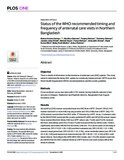| dc.contributor.author | Sarker, Bidhan Krishna | |
| dc.contributor.author | Rahman, Musfikur | |
| dc.contributor.author | Rahman, Tanjina | |
| dc.contributor.author | Rahman, Tawhidur | |
| dc.contributor.author | Khalil, Jubaida Jahan | |
| dc.contributor.author | Hasan, Mehedi | |
| dc.contributor.author | Rahman, Fariya | |
| dc.contributor.author | Ahmed, Anisuddin | |
| dc.contributor.author | Mitra, Dipak Kumar | |
| dc.contributor.author | Mridha, Malay Kanti | |
| dc.contributor.author | Rahman, Anisur | |
| dc.date.accessioned | 2022-05-24T05:52:21Z | |
| dc.date.available | 2022-05-24T05:52:21Z | |
| dc.date.copyright | 2020 | |
| dc.date.issued | 2020-11-05 | |
| dc.identifier.citation | Sarker, B. K., Rahman, M., Rahman, T., Rahman, T., Khalil, J. J., Hasan, M., . . . Rahman, A. (2020). Status of the WHO recommended timing and frequency of antenatal care visits in northern Bangladesh. PLoS ONE, 15(11) doi:10.1371/journal.pone.0241185 | en_US |
| dc.identifier.uri | http://hdl.handle.net/10361/16662 | |
| dc.description | This article was published in PLOS ONE by BMJ Journals [© 2020 Sarker et al. This is an open access article distributed under the terms of the Creative Commons Attribution License,] and the definite version is available at: https://doi.org/10.1371/journal.pone.0241185 The Journal's website is at: https://journals.plos.org/plosone/article?id=10.1371/journal.pone.0241185 | en_US |
| dc.description.abstract | Objective:
There is dearth of information on the timeliness of antenatal care (ANC) uptake. This study aimed to determine the timely ANC uptake by a medically trained provider (MTP) as per the World Health Organization (WHO) recommendations and the country guideline.
Methods
Cross-sectional survey was done with 2,731 women having livebirth outcome in last one year in Dinajpur, Nilphamari and Rajshahi districts, Bangladesh from August-November,2016.
Results
About 82%(2,232) women received at least one ANC from a MTP. Overall, 78%(2,142) women received 4 or more ANCs by any provider and 43%(1168) from a MTP. Only 14%(378) women received their first ANC at the 1st trimester by a MTP. As per 4 schedule visits by the WHO FANC model and the country guideline 8%(203) and 20%(543) women respectively received the first 2 timely ANC by a MTP; where only 1%(32) and 3%(72) received the first 3 visits timely and 0.6%(17) and 1%(29) received all the four timely visits. Factors significantly associated with the first two timely visits are: 10 or above years of schooling of women [adj. OR 2.13 (CI: 1.05, 4.30)] and their husbands [adj. OR 2.40 (CI: 1.31, 4.38)], women’s employment [adj. OR 2.32 (CI: 1.43, 3.76)], urban residential status [adj. OR 3.49 (CI: 2.46, 4.95)] and exposure to mass media [adj. OR 1.58 (CI: 1.07, 2.34)] at 95% confidence interval. According to the 2016 WHO ANC model, only 1.5%(40) women could comply with the first two ANC contacts timely by a MTP and no one could comply with all the timely 8 contacts.
Conclusion
Despite high coverage of ANC utilization, timely ANC visit is low as per both the WHO recommendations and the country guideline. For better understanding, further studies on the timeliness of ANC coverage are required to design feasible intervention for improving maternal and child health. | en_US |
| dc.language.iso | en_US | en_US |
| dc.publisher | PLOS ONE | en_US |
| dc.relation.uri | https://journals.plos.org/plosone/article?id=10.1371/journal.pone.0241185 | |
| dc.subject | Antenatal care | en_US |
| dc.subject | Northern Bangladesh | en_US |
| dc.subject | WHO | |
| dc.title | Status of the WHO recommended timing and frequency of antenatal care visits in Northern Bangladesh | en_US |
| dc.type | Journal Article | |
| dc.description.version | Published | |
| dc.contributor.department | https://doi.org/10.1371/journal.pone.0241185 | |
| dc.identifier.doi | https://doi.org/10.1371/journal.pone.0241185 | |

